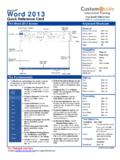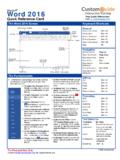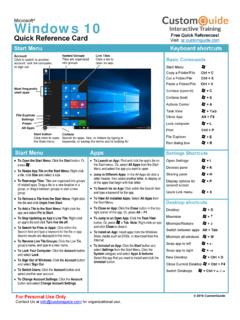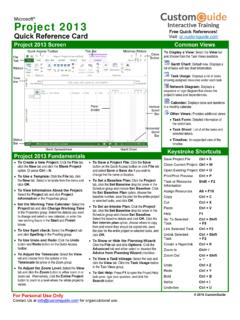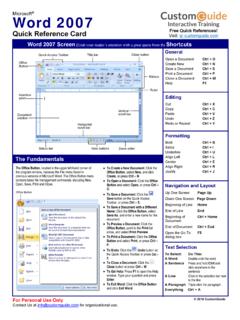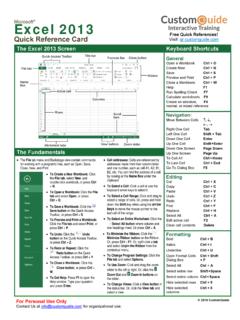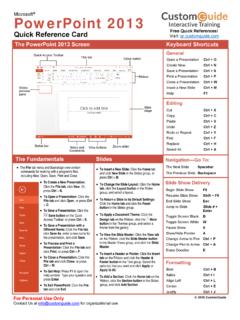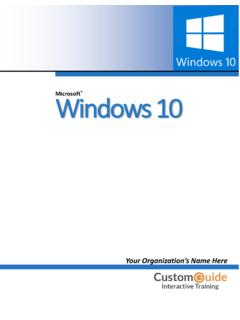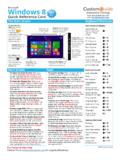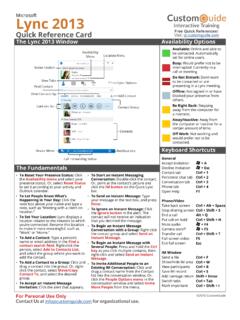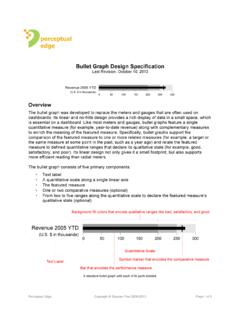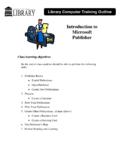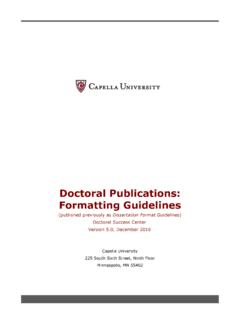Transcription of Access 2016 Quick Reference - Microsoft Office Training
1 | Working with Databases and Objects Keystroke Shortcuts Getting Started Window To Create a Database: Click a template category in the listand click the template you want to use. Click Create. Or, clickthe Blank desktop database button. To Open an Existing Database: Click the Open tab and clicka database in the Recent list or click Browse and browse for 2016 Screen General Open a Database Ctrl + O Close a Database Ctrl + W Print Current View Ctrl + P Delete Delete Undo Ctrl + Z Help F1 Delete Record Ctrl + - Cancel Changes Esc Insert Date Ctrl +.
2 Insert Time Shift + Ctrl + : Insert Value from Ctrl + Same Field in (Apostrophe) Previous Record Check Spelling F7 Switch Applications Alt + Tab Navigation Next Field Tab Previous Field Shift + Tab Next Screen Page Down Previous Screen Page Up First Record Ctrl + Last Record Ctrl + Toggle Navigation Pane F11 Database Objects Editing Cut Ctrl + X Copy Ctrl + C Paste Ctrl + V Find Ctrl + F Replace Ctrl + H Select All Ctrl + A Tables store related data in rows (records) and columns (fields). Queries view, filter, calculate, change, sort, and examine the data stored in tables.
3 Forms are custom screens that provide an easy way to enter and view data in a table. Reports present data from a table or query in a printed format. Macros automate common tasks and can be run by clicking a button or pressing a shortcut key. Modules are groups of procedures written in Visual Basic and used to automate tasks. Page objects have been replaced by Windows SharePoint Services. Pages in old databases can still be viewed but not edited in Internet Explorer. To Open an Object: Double-click the object in theNavigation Pane. To Create a New Object: Click the Create tab on theRibbon and click a button for the object or wizard youwant to use on the Objects bar.
4 To Modify an Object: Open the object or click its tab inthe window, click the Format tab on the Ribbon, clickthe View button in the Views group and select DesignView or Layout View. To Delete an Object: Select the object and pressDelete. Click Yes. To Rename an Object: Right-click the object, selectRename from the contextual menu, enter the newname, and press Enter. To Repair/Compress a Database: Click the DatabaseTools tab and select Compact and Repair Database. To Import Data: Click the External Data tab on theRibbon and click the type of file you want to import fromin the Import group.
5 Follow the onscreen instructions. To Export Data: Click the External Data tab on theRibbon and click the type of file you want to export to inthe Export group. Follow the onscreen View Properties Alt + Enter Open object in Ctrl + Enter Design View Save Object Ctrl + S Microsoft Access 2016 Quick Reference Card Table open in Datasheet ViewStatus bar Objects in the Navigation Pane Object Tabs Close button Title bar Quick Access Toolbar Ribbon Free Quick References! Visit: 2016 CustomGuideFor Personal Use Only Contact Us at for organizational use. Working with Tables Field Data Types Creating Table Relationships Linking Tables tells Access how two tables are related to each other.
6 The fields that you use to link two tables must contain the same concept in two different tables. A primary key field from one table is often used when linking two tables. 1. Click the Database Tools tab on the Ribbon and click the Relationships button in the Relationships group. 2. If necessary, click the Design tab and then click the Show Table button. In the Show Table window, select a table you want to link, click the Add button, and repeat for each table. Click Close. 3. Drag a field from one table and drop it on the related field in the second table. (Optional) Check the Enforce Referential Integrity box.
7 Click Create. Working with Table Data Database information can be directly added and modified from tables and some queries and forms. To Add a Field to a Table: Enter data in the cell below the Field Name column header. Or, in Datasheet View, click a Data Type option from the Fields tab under Table Tools. Your field will be added and you can give it a name. To Add a New Record: Enter data in the bottom row of the table. To Select a Record: Click the Record selector (grey square) to the left of the record. To Delete a Record: Select the record, click the Home tab on the Ribbon and click the Delete button in the Records group.
8 Click Yes. To Spell Check: Click the Home tab on the Ribbon and click the Spelling button in the Records group, or press F7. To Find Information: Place the cursor in the field that contains the value you want to search for, click the Home tab on the Ribbon and click the Find button in the Find group or press Ctrl + F. Type the value you want to search for in the Find What box and click Find Next. To Replace Information: Place the cursor in the field that contains the value you want to replace, click the Home tab on the Ribbon and click the Replace button in the Find group or press Ctrl + H.
9 Type the value you want to search for in the Find What box and the new value in the Replace With box. Click Find Next until you ve found what you re looking for, then click Replace or Replace All to replace every instance of the value. To Sort Information: Place the cursor in the field that you want to sort by, click the Home tab and click either the Ascending or Descending button in the Sort & Filter group. Or, right-click on the field and select the sort button from the contextual menu. To Filter Information: Place the cursor in the field that contains the values you want to filter by, click the Home tab on the Ribbon and click the Filter button in the Sort & Filter group.
10 Check the boxes for the values you want to filter for. To Remove a Filter: Click the Toggle Filter button in the Sort & Filter group. To Change a Field s Data Type: Select the field you want to change, click the Datasheet tab on the Ribbon, and click the Data Type list arrow in the Data Type & Formatting group. Select a data type. Data Type Description Short Text Stores text, numbers, or a combination of both, up to 255 characters long. Long Text Stores long text entries up to 64,000 characters long. Number Stores numbers that can be used in calculations. Date/Time Stores dates, times, or both.
